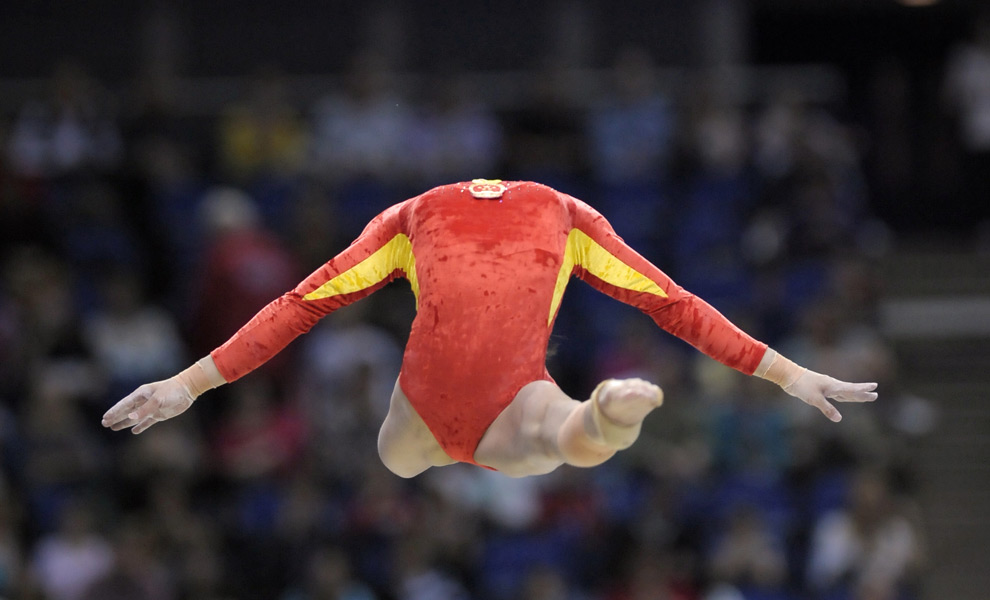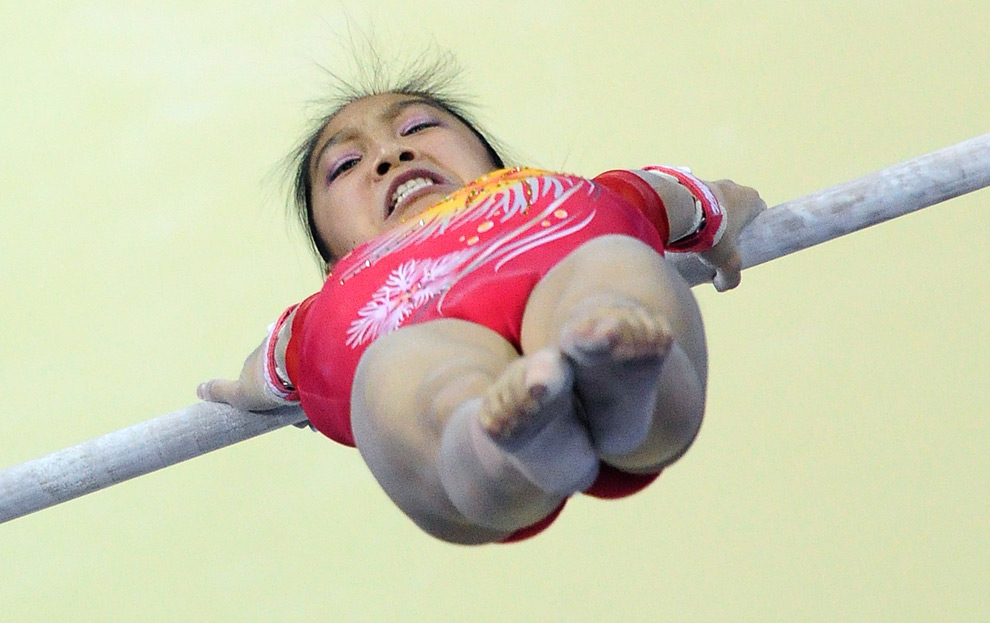Many of the more popular spectator sports involve athletes excelling at games the fans play not as well. Only a very few can go pro, but lots of people can shoot a basket, throw a football, catch a baseball, defend the goal, or sink a putt. And then there is gymnastics.

Not only is this athlete doing what you see here, but she is doing it while leaping on a balance beam. Maybe you might try to jump high into the air and land again on a hard surface that is four inches wide and four feet off the floor, but not me. Nor am I likely to do a poor back flip with a full twist vault, or a not so good iron cross. Without years of highly disciplined training, the level of difficulty is way beyond anything to be attempted by a weekend warrior.
But I digress. Perhaps by now the shock of the photograph above is being to wear off. There is something horrifying about decapitation, even when we know that the severing is an illusion. A trick of the camera, an accident of angle, we know intuitively that the head is merely out of our line of sight. And yet. The body works so well without it, the musculature is so perfectly developed and disciplined, it could almost double as a science fiction athlete in a future where everything has been genetically engineered for optimal performance, with all other aesthetic and moral values cut away as well.
The photograph may be showing us a glimpse of the future, but it also reveals thing or two about the present. Genetics aside, the athlete has been engineered for optimal performance, and so the image reveals the extraordinary specialization that goes into the higher echelons of modern sport–and other sectors of modern society. It also might hint at some of the costs for the individual athlete, who often sacrifices educational opportunities and much else in the short term while enduring chronic physical discomfort or worse later in life.
I think it also reveals a deeper condition that is intertwined with our visual experience. The obvious distortion in the visual image (the fictive decapitation) exposes the actual distortion of the body that occurs in many forms of training. Although images of athletes have been used since Greek antiquity to portray the Body Beautiful as a perfect expression of the natural physique, in fact, sport, like art of any sort, involves doing things that are not simply natural. Excellence in any cultural activity involves making the unusual so ingrained that it seems to be second nature. The athlete or artist or other performer takes what is arbitrary, contingent, artificial, and otherwise a matter of of choice and effort, and fashions it into an seemingly effortless act.
Our sense of beauty can beguile us on this point, and many photographs of gymnasts and other athletes may serve that denial of how strange, contorted, and otherwise artificial our use of our bodies can be as people dance, paint, do surgery, build houses, or sit at a computer and write. Nothing we do can be contrary to the laws of nature or our body’s inherent incapacities, but as we live in cultures of bodily discipline we learn to function as bodies without heads, heads without bodies, and many other equally odd designs.
What people don’t do, however, is develop a sense of their bodies as plastic material waiting to be formed and reformed under pressure. In fact, one use of both images and mirrors seems to be to maintain a sense of a proportionate bodily integrity. Which is why I am closing with this photograph:

The intact body is visible, but there still is something wrong. Now it seems that the athlete has become compressed by the powerful gravitational forces built up when torquing around the bar. The body is still trained and controlled, and one once again knows intuitively that the foreshortening is a visual trick and not the actual crushing of the body to produce the world’s shortest woman, and yet. . . . Second nature is again exposed: the body’s innate capabilities have been transformed into s specific and astonishing art, one that dazzles the mind. If you think about what is being revealed, however, you might realize that artistic excellence depends upon deformation, and that because it is a product of culture, the human being has no fixed form.
Photographs by Carl de Souza/AFP-Getty Images and Toby Melville/Reuters from the Artistic Gymnastics World Championships 2009 in London.
I think these pictures are really amazing. These pictures just show that the body can be an amazing work of art. I used to be a gymnast and I wish that I stuck with it because the discipline you learn about your body is incredible to me and you can see that in these pictures especially in the bars picture where the girl’s body is amazingly straight. With gymnastics I feel that the disciple starts with your mind and then your body because I feel that whatever you do in your mind is acted out with your body. The fact that her head can go all the way back like that when she does that means a lot about her and her body. It just shows the mechanics of the body and how they seem to be so easily altered in an image like this. My favorite line that they use is “the athlete has been engineered for optimal performance” because it is so true. I love that line because you can’t be born to be the perfect gymnast. It requires a lot of training and actually being a gymnast is very dangerous because of the amount of injuries that your body endures during your career can be harmful to their career and their future. I also like how they make a relation to that of the Greeks and the relation how they thought of the body as an art form. Overall I like the topics that were discussed for these photos because they could have been anything but the way that they talked about the body and the idea of the head decapitation in the first photo all the way to the idea of how the deformed body can be turned into an art piece that somehow dazzles the human mind.
These pictures just show that the body can be an amazing work of art.